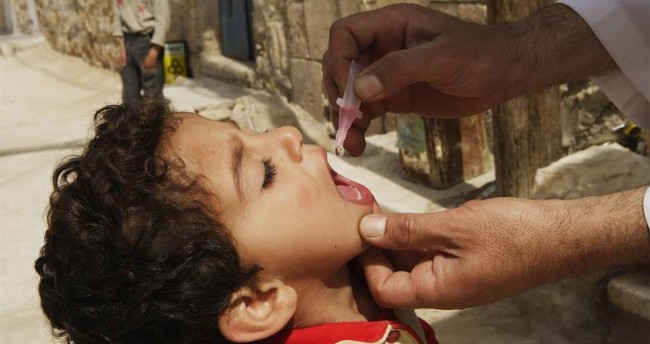Polio: The Latest Disaster to Befall Assad’s Syria
One more of the countless consequences of the continued rule of Syrian President Bashar Assad and its sanction by the international community is the confirmed outbreak of polio cases, the first in Syria in 14 years.
It is sad that polio, once one of the most feared diseases that paralyzed thousands of children every year, is back and could spread throughout the region due to the large amount of movement by Syrians fleeing their country.
In 2013, only three countries — Afghanistan, Nigeria and Pakistan — remain polio-endemic, down from more than 125 in 1988.
Will Syria now be added to this list?
The World Health Organization (WHO) has issued a surveillance alert for the region to “actively search for additional potential cases.” It also recommends all travellers to and from polio-infected areas be fully vaccinated.
It is all the more heartbreaking given that polio cases in Syria emerged as World Polio Day was being celebrated on October 24.
On Tuesday (October 29), WHO stated, “Following reports of a cluster of 22 acute flaccid paralysis (AFP) cases on October 17 in Syria, wild poliovirus type 1 (WPV1) has been isolated from 10 of the cases under investigation.”
It said most of the victims are very young — below two years of age — and were un- or under-immunized. Estimated immunization rates in Syria declined from 91 percent in 2010 to 68 percent in 2012.
Even before this laboratory confirmation, health authorities in Syria and neighboring countries had begun planning and implementing a comprehensive outbreak response, WHO says. On October 24, an already-planned large-scale supplementary immunization activity (SIA) was launched in Syria to vaccinate 1.6 million children against polio, measles, mumps and rubella, in both government-controlled and rebel areas.
Implementation of an SIA in Deir ez-Zor province commenced promptly when the first “hot cases” were reported.
WHO expects the larger-scale outbreak response across Syria and neighboring countries to begin in early November and to last at least six to eight months — depending on the area and based on evolving epidemiology.
It warns: “Given the current situation in Syria, frequent population movements across the region and subnational immunity gaps in key areas, the risk of further international spread of wild poliovirus type 1 across the region is considered to be high.”
Polio is a crippling and potentially fatal infectious disease. There is no cure, but there are safe and effective vaccines. The strategy to eradicate polio is therefore based on preventing infection by immunizing every child until transmission stops and the world is polio-free.
Polio (poliomyelitis) is a highly infectious disease caused by a virus. It invades the nervous system and can cause irreversible paralysis in a matter of hours.
Polio can strike at any age, but it mainly affects children under five years old. It is spread through person-to-person contact.
When a child is infected with wild poliovirus, the virus enters the body through the mouth and multiplies in the intestine. It is then shed into the environment through the faeces where it can spread rapidly through a community, especially in situations of poor hygiene and sanitation. If a sufficient number of children are fully immunized against polio, the virus is unable to find susceptible children to infect, and dies out.
Most people infected with the poliovirus have no signs of illness and are never aware they have been infected. These symptomless people carry the virus in their intestines and can “silently” spread the infection to thousands of others before the first case of polio paralysis emerges.
For this reason, WHO considers a single confirmed case of polio paralysis to be evidence of an epidemic –particularly in countries where very few cases occur.
Polio can be prevented through immunization. Polio vaccine, given multiple times, almost always protects a child for life.
In 1988, when the Global Polio Eradication Initiative began, polio paralyzed more than 1,000 children worldwide every day. Since then, 2.5 billion children have been immunized against polio thanks to the cooperation of more than 200 countries and 20 million volunteers, backed by an international investment of more than $8 billion.
WHO, in partnership with the Global Polio Eradication Initiative, the largest private-public partnership for health, has reduced polio by 99%. Polio now survives only among the world’s poorest and most marginalized communities, where it stalks the most vulnerable children. The Initiative’s goal is to reach every last child with polio vaccine and ensure a polio-free world for future generations
There are two forms of vaccine available to ward off polio – oral polio vaccine (OPV) and inactivated polio vaccine (IPV). Because OPV is an oral vaccine, it can be administered by anyone, even volunteers. One dose of OPV can cost as little as 11 U.S. cents.
According to WHO, polio cases have decreased by over 99% since 1988, from an estimated 350 000 cases then, to 223 reported cases in 2012. The reduction is the result of the global effort to eradicate the disease.
But it points out that as long as a single child remains infected, children in all countries are at risk of contracting polio. Failure to eradicate polio from these last remaining strongholds could result in as many as 200,000 new cases every year, within 10 years, all over the world.
May the children of Syria be protected from this disease.




You must be logged in to post a comment Login